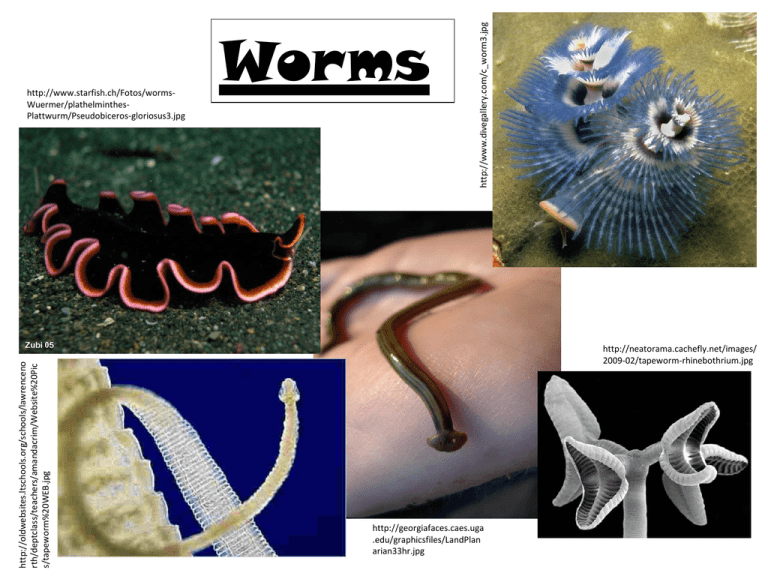
http://oldwebsites.ltschools.org/schools/lawrenceno
rth/deptclass/teachers/amandacrim/Website%20Pic
s/tapeworm%20WEB.jpg
http://www.divegallery.com/c_worm3.jpg
http://www.starfish.ch/Fotos/wormsWuermer/plathelminthesPlattwurm/Pseudobiceros-gloriosus3.jpg
Worms
http://neatorama.cachefly.net/images/
2009-02/tapeworm-rhinebothrium.jpg
http://georgiafaces.caes.uga
.edu/graphicsfiles/LandPlan
arian33hr.jpg
Phylum Platyhelminthes
•
•
•
•
•
•
“The Flatworms” (dorsoventrally flat)
Triploblastic! (Organ systems seen)
Mouth, but no anus
Most monoecious
More complex nervous system
4 Main Classes:
– Turbellaria
– Monogenea
– Trematoda
– Cestoidea
• Class Turbellaria: Free living Flatworms
– Mostly bottom dwellers in water (fresh & marine)
– Named for the “turbulence” of their beating cilia
– Movement by layers of muscle cells and rhabdites
(cells that form mucus)
– Feeding by pharynx (mouth); mostly carnivorous
– Respiration by diffusion through the body wall
– Simple kidneys = protonephridia (with flame cells)
– Simple brain = cerebral ganglia
– 2 simple eyes = ocelli
– Other sensory body parts: auricles on sides of
head
Planaria
• Reproduction:
http://highered.mcgraw-hill.com/sites/dl/free/0078664276/281029/ccq_ch12_q4a.gif
– Asexual (by transverse fission- producing zooids)
– Sexual (cross-fertilization- penis inserted; eggs laidsometimes in a cocoon)
http://www.eeob.iastate.edu/
faculty/DrewesC/htdocs/plan
aria-cocoonR.jpg
penis
transverse fission
http://wpcontent.answers.com/
wikipedia/commons/thumb/3/38
/Flatworm_sex.png/200pxFlatworm_sex.png
http://www.rzuser.uniheidelberg.de/~bu6/pow.jpg
http://science.kukuchew.com/wpcontent/uploads/2009/04/rimg012
1flatwormcrop.jpg
http://bioweb.uwlax.edu/zoolab/Images/Lab-4a%20Images/Lab_4a-01a.jpg
http://farm1.static.flickr.com/187/438039243_fccd05bd4f.jpg
Marine Turbellaria…
• Class Monogenea
– Mostly external parasites of freshwater and
marine fishes (attach to gills)
http://www.uen.org/utahlin
k/tours/admin/tour/18753/
18753monogenea.gif
http://www.sardi.sa.gov.au/__data/as
sets/image/0007/84148/mp_Hexosto
ma.gif
http://www.digsfish.com/imgs/finfish/figure%204.jpg
• Class Trematoda: Parasitic Flatworms-“Flukes”
– Almost all are parasites of vertebrates
– All have various body parts for attachment
– Subclass Aspidogastrea: mollusc fluke
• Opisthaptor = holdfast organ on entire ventral surface
• NO oral sucker
– Subclass Digenea: majority of flukes
• 2 large suckers: oral sucker and acetabulum (below oral
sucker)
• May have multiple hosts (including humans)
Subclass Aspidogastrea
(ventral view)
http://parasitology.informatik.uni-wuerzburg.de/login/b/tn_me14236.png
http://www.nutridirect.co.uk/images/fluke.jpg
Subclass Digenea:
• Popular Trematode Parasites of Humans:
– Chinese liver fluke
– Sheep liver fluke
– Blood flukes
Chinese Liver Fluke:
picked up by
humans who eat
infected raw fish
http://www.fao.org/docrep/008/y5970e/y5970e04.jpg
http://www.phsource.us/PH/HEL
M/Helminth_images/Clonorchis
%20sinensis.jpg
http://siera104.com/images/bio/flatroundrotifers/fluke.jpg
http://images.wool.com/pub/liver_fluke_cycle.gif
Sheep Liver Fluke:
Picked up by humans who
eat the freshwater plant
watercress
http://www.kstate.edu/parasitology/625t
utorials/FIGfasciola08.jpg
http://www.uen.org/utahlink/activities/uploads/7487_a_schistosoma_in_copula.gif
http://siera104.com/images/bio/flatroundrotifers/shistomsoma.jpg
Blood Flukes:
Attach to human skin
from infected water
source
http://animal.discovery.com
/tv/a-list/creaturecountdowns/horrors/images
/fluke-horrors.jpg
• Class Cestoidea: The Tapeworms
– Most live in vertebrate digestive system
– Adults lack pigment (white color)
– Can grow to large lengths (up to 25 m)
– No mouth or digestive tract (they absorb nutrient
directly across body wall)
– Nervous system not as complex as other
platyhelminthes
– Monoecious
– Adults are made of repeating body units
(proglottids- hold reproductive organs)
– Subclass Cestodaria = no proglottids
• Parasites of fishes
• Subclass Eucestoda: True Tapeworms
– 3 body regions:
http://www.astrographics.com/GalleryPrints/Display/GP2104.jpg
http://www.fastonline.org/CD3WD_40/LSTOCK/001/SA_Inf
oPaks/docs/Tapeworm/worm1.gif
• Scolex- anterior end with suckers and hooks
• Neck- area of growing proglottids
• Stobila- posterior area of proglottids
***proglottids closer to posterior are more mature
http://farm2.static.flickr.com/1251/
617427668_e747238c1a.jpg
http://faculty.clintoncc.suny.edu/faculty/michael.gregory/files/Bio%20102/Bio%20102%20lec
tures/Animal%20Diversity/lower%20invertebrates/tapeworm1.jpg
• Popular Tapeworms Parasites of Humans:
– Beef tapeworm
– Pork tapeworm
– Broad fish tapeworm
All ingested by infected meat






